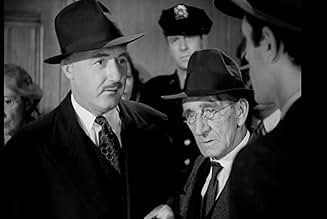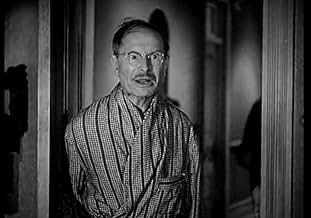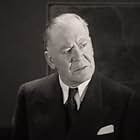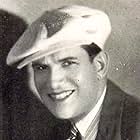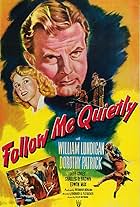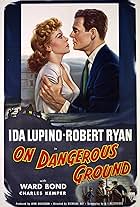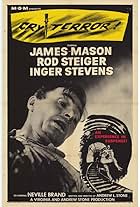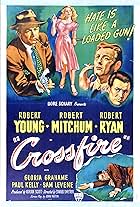IMDb RATING
6.8/10
4.7K
YOUR RATING
An aspiring reporter is the key witness at the murder trial of a young man accused of cutting a café owner's throat, and is soon accused of a similar crime himself.An aspiring reporter is the key witness at the murder trial of a young man accused of cutting a café owner's throat, and is soon accused of a similar crime himself.An aspiring reporter is the key witness at the murder trial of a young man accused of cutting a café owner's throat, and is soon accused of a similar crime himself.
Bobby Barber
- Giuseppe
- (uncredited)
Vince Barnett
- Cafe Customer
- (uncredited)
Lee Bonnell
- Reporter
- (uncredited)
Harry C. Bradley
- Court Clerk
- (uncredited)
Lynton Brent
- Cabdriver at Nick's
- (uncredited)
Jack Cheatham
- Detective
- (uncredited)
Storyline
Did you know
- TriviaPeter Lorre owed RKO two days on his contract and was given this role with a few scenes and some lines. He received top billing largely because his was the most recognizable name among the film's principal cast.
- GoofsAt the beginning, after Mike joins Jane at the luncheon counter, she is holding a piece of toast in her left hand; i.e., next to Mike, who is sitting on her left. On the next cut, a shot of the mirror showing the reflection of Jane holding the toast and Mike pointing, the image in the mirror shows Jane holding the toast in her hand further away from Mike. Then, when it cuts back to them, Jane is no longer holding the toast.
- Quotes
The Stranger: I want a couple of hamburgers, and I'd like them raw.
- Alternate versionsThere is an Italian edition of this film on DVD, distributed by DNA srl, "MAD LOVE (1935) + STRANGER ON THE THIRD FLOOR (1940)" (2 Films on a single DVD), re-edited with the contribution of film historian Riccardo Cusin. This version is also available for streaming on some platforms.
- ConnectionsFeatured in Aweful Movies with Deadly Earnest: Stranger on the Third Floor (1969)
Featured review
The Film Noir Encyclopeia lists Stranger as the first true film noir. It's not hard to see why. The lengthy interior dialog, the grotesque dream sequence, and the expressionist lighting, all bespeak the arrival of a noir universe. Over the next ten or so years, this European style would encompass a number of film genres, seeping even into that most American of all, the Western ("Blood on the Moon", "Roughshod", et al.). I can only imagine how 1940's audiences greeted this abrupt departure on first showing.
Except for Lorre, it's a no-name cast, although Tallichet makes for a charming leading lady with a captivating smile. The absence of a familiar face (John McGuire) in the male lead actually helps. Instead of seeing a celebrity in a starring role, we see an unknown that might even be us. And so, both he and we are drawn deeper into a nightmarish web of guilt. Notice how the lighting becomes steadily darker as McGuire's anguish deepens, with shadows that are almost all appropriately angular and threatening. Also, note director Ingster's very real feel for the ethnic vibrancy of a New York street even though it's recreated on an RKO sound stage. This sense of a community life outside the third floor makes for an interesting contrast with McGuire's growing inward turn.
Too bad the script fails to match the visuals in imagination and stylishness. It's really pretty conventional, except for the nicely ironical twist of having the jury-trial deficiencies turned back upon McGuire in the dream sequence. Good thing they had Lorre outfitted with buck teeth and doing an exquisitely loony menace, because the climax itself is very unimaginatively staged. It could have come from a thousand other more ordinary films. Anyway, for fans of noir and movie historians, this obscure little production remains essential and entertaining viewing.
Except for Lorre, it's a no-name cast, although Tallichet makes for a charming leading lady with a captivating smile. The absence of a familiar face (John McGuire) in the male lead actually helps. Instead of seeing a celebrity in a starring role, we see an unknown that might even be us. And so, both he and we are drawn deeper into a nightmarish web of guilt. Notice how the lighting becomes steadily darker as McGuire's anguish deepens, with shadows that are almost all appropriately angular and threatening. Also, note director Ingster's very real feel for the ethnic vibrancy of a New York street even though it's recreated on an RKO sound stage. This sense of a community life outside the third floor makes for an interesting contrast with McGuire's growing inward turn.
Too bad the script fails to match the visuals in imagination and stylishness. It's really pretty conventional, except for the nicely ironical twist of having the jury-trial deficiencies turned back upon McGuire in the dream sequence. Good thing they had Lorre outfitted with buck teeth and doing an exquisitely loony menace, because the climax itself is very unimaginatively staged. It could have come from a thousand other more ordinary films. Anyway, for fans of noir and movie historians, this obscure little production remains essential and entertaining viewing.
- dougdoepke
- Jan 7, 2008
- Permalink
- How long is Stranger on the Third Floor?Powered by Alexa
Details
Box office
- Budget
- $171,200 (estimated)
- Runtime1 hour 4 minutes
- Color
- Aspect ratio
- 1.37 : 1
Contribute to this page
Suggest an edit or add missing content

Top Gap
By what name was Stranger on the Third Floor (1940) officially released in India in English?
Answer


